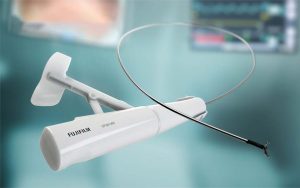
Endoscopic Submucosal Dissection (ESD) is now recognized across the globe as a preferred treatment option for certain advanced gastrointestinal lesions, but adoption has been very limited in the US. For many US patients, Endoscopic Mucosal Resection (EMR) and/or surgical resection (complete or partial organ removal) are the only treatment options when a large pre-cancerous lesion or early-stage cancer is encountered. While EMR and surgical intervention are both critical options that will remain prevalent, it is increasingly clear that ESD deserves a place in the US treatment algorithm, especially with the newly published ASGE Guidelines.
Envisioning a future where curative resection of advanced lesions may be achieved with a single endoscopic procedure, thereby minimizing risk of recurrence and avoiding potentially life altering surgery, FUJIFILM has worked alongside leading physicians to develop specialized tools like TRACMOTION.
With TRACMOTION, Fujifilm aimed to create a device that could 1) simplify the procedure, 2) enhance its safety, 3) make it more time-efficient, and 4) shorten the ESD learning curve.
TRACMOTION, developed in the U.S., had its roots in addressing the complexities of ESD, a procedure that traditionally has demanded years of practice to gain expertise. Once mastered, ESD becomes a crucial tool for precisely removing targeted tissues and lesions endoscopically. With TRACMOTION, Fujifilm aimed to create a device that could 1) simplify the procedure, 2) enhance its safety, 3) make it more time-efficient, and 4) shorten the ESD learning curve.
After years of design, verification, and limited market evaluation, TRACMOTION was first launched in the U.S. in November 2021. Physicians have since been assessing its benefits, including improved safety, reduced procedure time, and overall simplification.
A pivotal peer-reviewed publication in IGIE in December 2022 compared TRACMOTION to the popular “clip and line” traction method. The findings revealed that the TRACMOTION steering arm, particularly in the hands of trainee endoscopists, led to faster dissection times compared to the clip and line method, and with a reduced technical workload.1
Another study published in the Journal of DEN in 2023 demonstrated that TRACMOTION-assisted ESD resulted in faster submucosal dissection and lower physical demand than conventional pocket/tunneling techniques.2 In addition, the 2023 retrospective multicenter analysis further supported TRACMOTION’s high resection rates and excellent safety profiles during ESD.3
When all three studies are considered together, they tell a compelling story about the benefits of performing ESD utilizing TRACMOTION, affirming Fujifilm’s goals of simplifying, making safer, shortening the time required for ESD through the development of this novel device, and thus expanding the number of physicians interested and capable of completing this noninvasive procedure.
Published Clinical Study Abstracts
 Michael Vargo is the Product Manager for the single-use endoscopy device portfolio at FUJIFILM Healthcare Americas Corporation.
Michael Vargo is the Product Manager for the single-use endoscopy device portfolio at FUJIFILM Healthcare Americas Corporation.